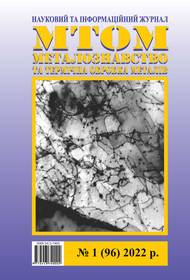IMPROVING THE QUALITY OF MAGNESIUM-SOLUBLE BIOLOGICAL ALLOY FOR IMPLANTS
DOI:
https://doi.org/10.30838/J.PMHTM.2413.240422.67.845Keywords:
magnesium alloy, carbonaceous materials, filtration;, modification, refining, micrograin, mechanical properties, refining and modifying abilityAbstract
Formulation of the problem. Currently, biosoluble materials are widely used for the manufacture of implants, among which the most promising are magnesium alloys. Magnesium is a natural element of the body. It is contained in bone and muscle tissue and involved in various metabolic processes. In addition, magnesium and its biocorrosion products have excellent biocompatibility. The main advantage of magnesium alloys is the positive effect magnesium has on the human body, but their quality is not satisfactory for use in the human body. Improved refining and modification processes of liquid melt can increase the properties of magnesium alloys. Purpose of research: to investigate and test various carbonaceous materials for refining and modifying magnesium melt. Method. Optical microscopy, application of standard techniques for determining the mechanical properties of magnesium alloy and special techniques for determining the refining and modifying ability of various carbon-containing materials. Results. The technology of cast magnesium alloys modification for Mg – Zr − Nd system by dispersed graphite powder is proposed. It is shown that the optimal carbon additive in the quantity of 0,05…0,1 % improves the mechanical properties due to grain grinding and additional strengthening of structural components. A complex filter containing equal quantity of magnesite, graphite and limestone is proposed. It provides an increased level of melt refining to obtain high quality casting. It is shown that the use of a complex carbon-containing filter provides not only efficient melt refining, but also its additional modification. In alloy structure the increased quantity of intermetallic γ-phase is observed, that provides increase the microhardness of alloy structural components and promotes increase of its physical-mechanical characteristics. Scientific novelty. The structure and properties of cast magnesium alloy for
Mg –Zr – Nd system during modification with dispersed graphite powder and its filtration through carbon-containing materials are investigated. Practical significance. The developed complex technology for processing the liquid melt of magnesium alloys for the Mg – Zr − Nd system allows to increase the yield of suitable casting and improve its quality.

Downloads
Published
Issue
Section
License
Authors that are published in this journal agree to follow the conditions:
Authors reserve the right to the authorship of his work and cede the right to the journal of first publication of this work on conditions of the license under the Creative Commons Attribution License, which allows others to distribute it freely with the obligatory reference to the author of the original work and the first publication of the work in this journal.
